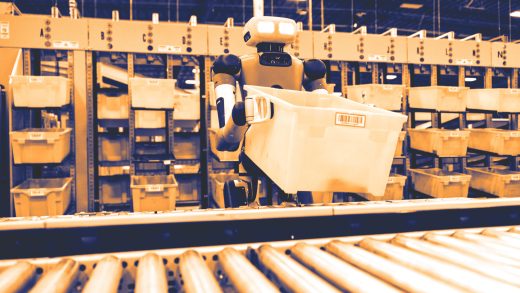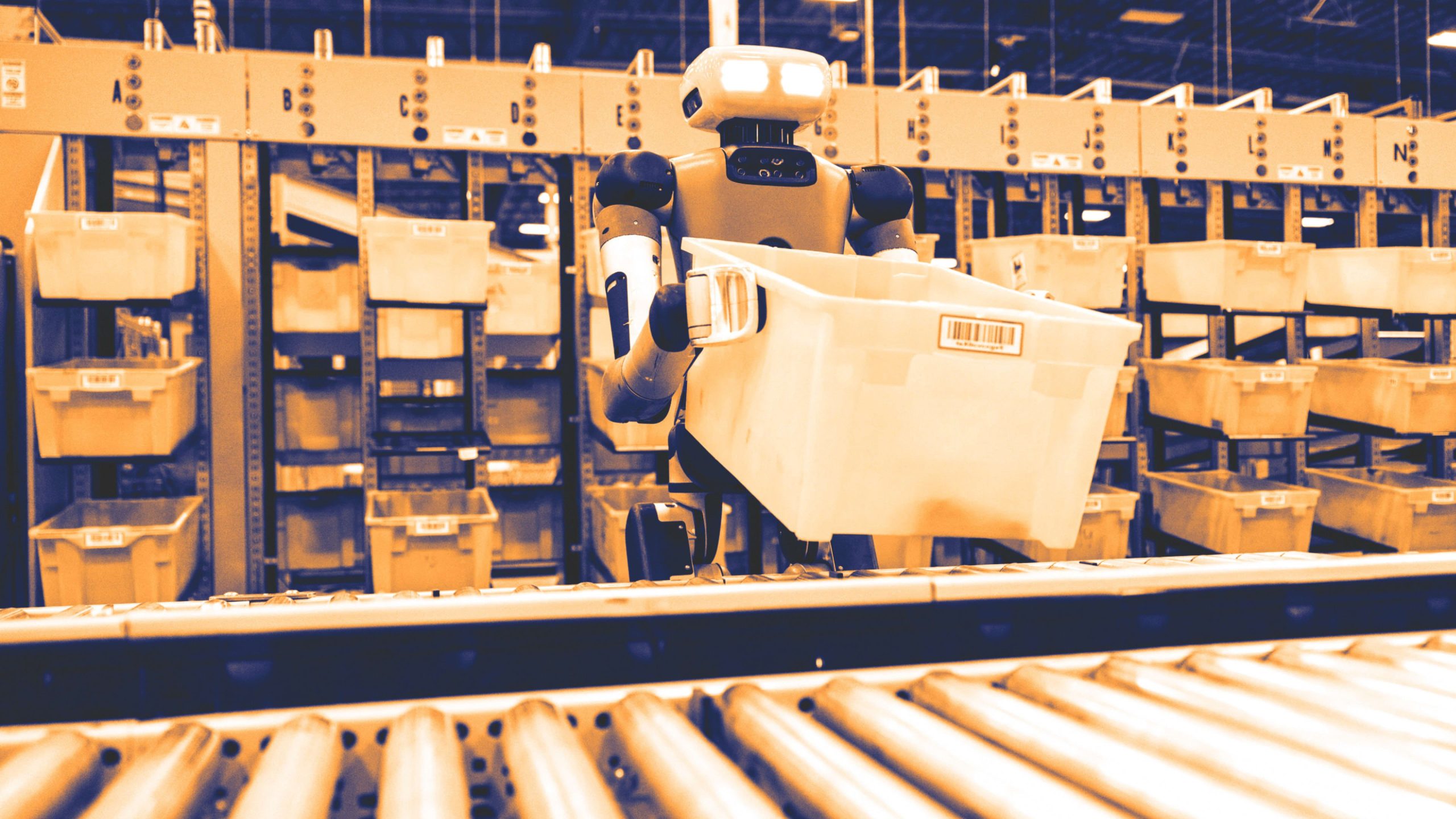Agility Robotics CEO Peggy Johnson insists the robots are only coming for the jobs we don’t want
June 07, 2024
Agility Robotics CEO Peggy Johnson insists the robots are only coming for the jobs we don’t want
The Agility Robotics CEO talks humanoids, AR, and startup culture on the latest episode of the ‘Rapid Response’ podcast.
In the era of AI, are Hollywood’s threatening sci-fi robots poised to come to life? Peggy Johnson, CEO of Agility Robotics, separates hype from reality, explaining how Agility’s humanoid robot, Digit, is entering the industrial workforce today. The former CEO of augmented reality startup Magic Leap, Johnson shares what makes robot tech more tangible than AR and explores the sensitive relationship between robotics and human-held jobs.
This is an abridged transcript of an interview from Rapid Response, hosted by the former editor-in-chief of Fast Company Bob Safian. From the team behind the Masters of Scale podcast, Rapid Response features candid conversations with today’s top business leaders navigating real-time challenges. Subscribe to Rapid Response wherever you get your podcasts to ensure you never miss an episode.
From AR to robots
You became CEO of Magic Leap in the heat of the pandemic. Now you’ve taken on a new CEO role again at Agility. Can you catch us up on how you got here?
At Magic Leap, we successfully turned things around. We repointed the company towards enterprise. I felt like I’d done what I came there to do. I think augmented reality is still very early days. It will happen. Even looking at the Apple Vision Pro, it’s going to take some time. And while I love the game-changing aspect of augmented reality, the trajectory is on a slower slope than robotics.

And when I saw the opportunity at Agility, it appeared they had product market fit and a huge demand for what they could do—which is putting robots into many open jobs that people don’t want. I felt like that’s the spot for me. So I made the jump and I’m super excited about the space. Humanoids are kind of having a moment right now. There’s this huge tailwind of open jobs that are kind of repetitive, dull, and people don’t want. It’s these jobs that have doubled over the past five years from about 600,000 open jobs to about over a million. When you can’t find humans to do these jobs, humanoids can play that role.
Meet Digit
There are all kinds of robots that are used in business — a lot of them look like motorized carts or things like that. But Agility has this humanlike robot, that you called Digit. So why is there this sudden burst of attention of humanlike robots?
In warehouses, automation has been around for over a decade. But there’s pockets still with humans that are moving a box from a conveyor belt over to an automated put wall. You can think of that as the Achilles’ heel of all of that fantastic automation. Humanoids can work for long hours, they don’t get hurt, they don’t get emotional, they don’t have anything that you have to worry about.
When humanoids are deployed, the job for a human is to manage the fleet and the interaction between the robots and the other automated facilities. And that is something that looks more like a career.
I’ve seen videos of Digit. Even the videos are a little spooky. What kind of relationships do the human workers have with the robots?
We thought a lot about that. For instance, we have a head on Digit. And you can do different things with the eyes, like sparkles and hearts. There is a positive reaction with humans. There is a connection there because of that head and the fact that there are eyes. But mostly, humans and humanoids work separately. The idea of what’s called “collaborative robots” is a little bit further down the line. There’s very high safety standards.
Is Digit a “he” . . . A “she”?
I refer to it as an “it” oftentimes. But people do want to put characterization on the humanoid robot. We let them do what they’d like.
You’re leaning into this industrial use. Is there a vision for Digit to be in retail environments, interacting with customers? Or is that sort of a different track?
We’re only starting with these industrial applications because the need is so high. But this is a multipurpose humanoid. So it’s meant to go off into those areas. In fact, we’re already talking to customers in retail and transportation.
You’ve seen a few of the consumer robots come and go. Households are pretty messy places. Things inside of a warehouse are much more structured. So the need is greater there. And that’s where we’re going to focus. And that’s where the revenue is.
How AI can level-up humanoids
How are you thinking about using AI to change Digit?
We’ve been using AI in the form of reinforcement learning. So it’s been part of how we’ve developed Digit. The big opportunity that we see going forward is this idea of Digit’s semantic intelligence. So, giving Digit unstructured commands. The other day, we said, “go pick up all this trash” and Digit looked around, picked up the trash, and put it in the right bins—recycle, paper, or landfill. But going forward, AI is going to help us teach Digit new skills much more quickly.
You don’t want to use AI fully to control the robot right now. ‘Cause as we know, it’s not always perfect. And when you have a robot that weighs 160 pounds or so, and has all the torque to lift up heavy things, you want to be controlling that with a known platform. And so, until we’re much further along with AI, we aren’t going to make that swap.
Transitioning from a big org to a scrappy startup
You were a first time CEO at Magic Leap. What did you learn from that experience that you’re applying now? Like, what are you doing differently?
When I first stepped in at Magic Leap, they were chasing a lot of markets and we narrowed that down. That’s the same here—we get a lot of attention from companies who have innovation departments, for instance. I respect the innovation departments, but if they don’t have an intention to deploy and a problem to solve, we don’t focus there. We pick up and move on. We don’t want to be an interesting demo for someone’s boardroom, frankly. This is not demoware. We’re not doing backflips and making coffee.
When you left Microsoft, it was sort of just starting to come out of hibernation in a certain way. And now thanks to co-pilot and the arrangement with OpenAI, things are just cooking over there. Do you ever think about the decision to leave and wonder, “what if I’d stayed?”
Actually, never. I loved my time there. I loved working for Satya Nadella. I learned so much from him. He’s clearly an iconic leader, but I remember very clearly the day I made up my mind. It was actually only a few weeks into COVID lockdown at the time. My job in particular slowed down. It was running biz dev, very outwardly facing. I got on planes all the time—that was not available anymore.
So I really sat and thought about where I was in my career, and I had always wanted to be a CEO. And I think like a lot of people, you keep saying, “well, if I just had a little more experience here, a little more experience there, then I’ll be ready.” But I started looking.
Now that I’ve had the experience at Magic Leap and Agility, I could never see myself going back. I like the startup environment. I like the pace. I like the freedom and the flexibility to make decisions. The bigger the company is, the harder it is to get to a yes or no. And so I love the fast-paced environment at startups. I’m at the point in my career where I can do anything I want. And this is what I want to do. I love it.
ABOUT THE AUTHOR
Fast Company
(23)



